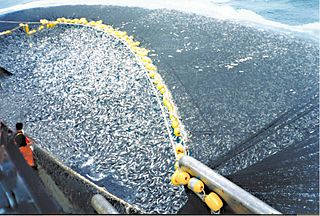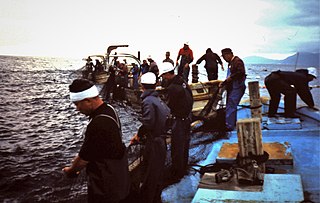Related Research Articles

Halibut is the common name for three flatfish in the genera Hippoglossus and Reinhardtius from the family of right-eye flounders and, in some regions, and less commonly, other species of large flatfish.

Angling is a fishing technique that uses a fish hook or "angle" attached to a fishing line to tether individual fish in the mouth. The fishing line is usually manipulated via a fishing rod, although rodless techniques such as handlining and longlining also exist. Modern angling rods are usually fitted with a reel that functions as a cranking device for storing, retrieving and releasing out the line, although Tenkara fishing and cane pole fishing are two rod-angling methods that do not use any reel. The hook itself can be additionally weighted with a dense tackle called a sinker, and is typically dressed with an appetizing bait to attract the fish and enticing it into swallowing the hook, but sometimes an inedible fake bait with multiple attached hooks is used instead of a single hook with edible bait. A bite indicator, such as a float or a quiver tip, is often used to relay underwater status of the hook to the surface.
In population ecology and economics, maximum sustainable yield (MSY) is theoretically, the largest yield that can be taken from a species' stock over an indefinite period. Fundamental to the notion of sustainable harvest, the concept of MSY aims to maintain the population size at the point of maximum growth rate by harvesting the individuals that would normally be added to the population, allowing the population to continue to be productive indefinitely. Under the assumption of logistic growth, resource limitation does not constrain individuals' reproductive rates when populations are small, but because there are few individuals, the overall yield is small. At intermediate population densities, also represented by half the carrying capacity, individuals are able to breed to their maximum rate. At this point, called the maximum sustainable yield, there is a surplus of individuals that can be harvested because growth of the population is at its maximum point due to the large number of reproducing individuals. Above this point, density dependent factors increasingly limit breeding until the population reaches carrying capacity. At this point, there are no surplus individuals to be harvested and yield drops to zero. The maximum sustainable yield is usually higher than the optimum sustainable yield and maximum economic yield.

Overfishing is the removal of a species of fish from a body of water at a rate greater than that the species can replenish its population naturally, resulting in the species becoming increasingly underpopulated in that area. Overfishing can occur in water bodies of any sizes, such as ponds, wetlands, rivers, lakes or oceans, and can result in resource depletion, reduced biological growth rates and low biomass levels. Sustained overfishing can lead to critical depensation, where the fish population is no longer able to sustain itself. Some forms of overfishing, such as the overfishing of sharks, has led to the upset of entire marine ecosystems. Types of overfishing include: growth overfishing, recruitment overfishing, ecosystem overfishing.
The goal of fisheries management is to produce sustainable biological, environmental and socioeconomic benefits from renewable aquatic resources. Wild fisheries are classified as renewable because the organisms of interest usually produce an annual biological surplus that with judicious management can be harvested without reducing future productivity. Fishery management employs activities that protect fishery resources so sustainable exploitation is possible, drawing on fisheries science and possibly including the precautionary principle.

The Common Fisheries Policy (CFP) is the fisheries policy of the European Union (EU). It sets quotas for which member states are allowed to catch each type of fish, as well as encouraging the fishing industry by various market interventions. In 2004 it had a budget of €931 million, approximately 0.75% of the EU budget.

The Magnuson–Stevens Fishery Conservation and Management Act (MSFCMA), commonly referred to as the Magnuson–Stevens Act (MSA), is the legislation providing for the management of marine fisheries in U.S. waters. Originally enacted in 1976 to assert control of foreign fisheries that were operating as close as 12 nautical miles off the U.S. coast, the legislation has since been amended, in 1996 and 2007, to better address the twin problems of overfishing and overcapacity. These ecological and economic problems arose in the domestic fishing industry as it grew to fill the vacuum left by departing foreign fishing fleets.

Blast fishing, fish bombing, or dynamite fishing is a destructive fishing practice using explosives to stun or kill schools of fish for easy collection. This often illegal practice is extremely destructive to the surrounding ecosystem, as the explosion often destroys the underlying habitat that supports the fish. The frequently improvised nature of the explosives used, and undetonated charges, means danger for fishermen and divers as well, with accidents and injuries.
Individual fishing quotas (IFQs), also known as "individual transferable quotas" (ITQs), are one kind of catch share, a means by which many governments regulate fishing. The regulator sets a species-specific total allowable catch (TAC), typically by weight and for a given time period. A dedicated portion of the TAC, called quota shares, is then allocated to individuals. Quotas can typically be bought, sold and leased, a feature called transferability. As of 2008, 148 major fisheries around the world had adopted some variant of this approach, along with approximately 100 smaller fisheries in individual countries. Approximately 10% of the marine harvest was managed by ITQs as of 2008. The first countries to adopt individual fishing quotas were the Netherlands, Iceland and Canada in the late 1970s, and the most recent is the United States Scallop General Category IFQ Program in 2010. The first country to adopt individual transferable quotas as a national policy was New Zealand in 1986.

Natural resource management (NRM) is the management of natural resources such as land, water, soil, plants and animals, with a particular focus on how management affects the quality of life for both present and future generations (stewardship).

The environmental impact of fishing includes issues such as the availability of fish, overfishing, fisheries, and fisheries management; as well as the impact of industrial fishing on other elements of the environment, such as bycatch. These issues are part of marine conservation, and are addressed in fisheries science programs. According to a 2019 FAO report, global production of fish, crustaceans, molluscs and other aquatic animals has continued to grow and reached 172.6 million tonnes in 2017, with an increase of 4.1 percent compared with 2016. There is a growing gap between the supply of fish and demand, due in part to world population growth.
Discards are the portion of a catch of fish which is not retained on board during commercial fishing operations and is returned, often dead or dying, to the sea. The practice of discarding is driven by economic and political factors; fish which are discarded are often unmarketable species, individuals which are below minimum landing sizes and catches of species which fishermen are not allowed to land, for instance due to quota restrictions. Discards form part of the bycatch of a fishing operation, although bycatch includes marketable species caught unintentionally. Discarding can be highly variable in time and space as a consequence of changing economic, sociological, environmental and biological factors.
The Quota Management System (QMS) is a type of individual fishing quota that is used in New Zealand to manage fish stocks.
A community-supported fishery (CSF) is an alternative business model for selling fresh, locally sourced seafood. CSF programs, modeled after increasingly popular community-supported agriculture programs, offer members weekly shares of fresh seafood for a pre-paid membership fee. The first CSF program was started in Port Clyde, Maine, in 2007, and similar CSF programs have since been started across the United States and in Europe. Community supported fisheries aim to promote a positive relationship between fishermen, consumers, and the ocean by providing high-quality, locally caught seafood to members. CSF programs began as a method to help marine ecosystems recover from the effects of overfishing while maintaining a thriving fishing community.
Ocean governance is the conduct of the policy, actions and affairs regarding the world's oceans. Within governance, it incorporates the influence of non-state actors, i.e. stakeholders, NGOs and so forth, therefore the state is not the only acting power in policy making. However, ocean governance is complex because much of the ocean is a commons that is not ‘owned’ by any single person or nation/state. There is a belief more strongly in the US than other countries that the “invisible hand” is the best method to determine ocean governance factors. These include factors such as what resources we consume, what price we should pay for them, and how we should use them. The underlying reasoning behind this is the market has to have the desire in order to promote environmental protection, however this is rarely the case. This term is referred to as a market failure. Market failures and government failures are the leading causes of ocean governance complications. As a result, humankind has tended to overexploit marine resources, by treating them as shared resources while not taking equal and collective responsibilities in caring for them.

Fisheries law is an emerging and specialized area of law. Fisheries law is the study and analysis of different fisheries management approaches such as catch shares e.g. Individual Transferable Quotas; TURFs; and others. The study of fisheries law is important in order to craft policy guidelines that maximize sustainability and legal enforcement. This specific legal area is rarely taught at law schools around the world, which leaves a vacuum of advocacy and research. Fisheries law also takes into account international treaties and industry norms in order to analyze fisheries management regulations. In addition, fisheries law includes access to justice for small-scale fisheries and coastal and aboriginal communities and labor issues such as child labor laws, employment law, and family law.
Adam Soliman is the director of The Fisheries Law Centre. He is a researcher focused on legal and economic issues in Fisheries. He teaches fisheries law in several countries and advocates for further access to justice in small-scale fisheries. He researches and conducts analysis to issues in fisheries management with special focus on small-scale fisheries. He specializes in fisheries management scheme and property rights particularly in catch shares and other management schemes.
Gulf Wild is a nonprofit organization operating in the Gulf of Mexico. Gulf Wild works with commercial fishermen to encourage and facilitate fishery conservation and innovation. Gulf Wild has implemented traceability practices including placing a numbered gill tag on every Gulf Wild fish. This numbered tag tracks who harvested the fish, from where, and at what port the fish landed. Consumers can use the gill tag number to access this information via the Gulf Wild website.
H. Scott Gordon (1924–2019) was a Canadian economist. He was born in Halifax, Nova Scotia. His seminal 1954 article Economic Theory of a Common Property Resource: The Fishery marked the beginning of the modern economics study of fisheries. He spent most of his career teaching and writing in the history and philosophy of economics, including the books Welfare, Justice, and Freedom (1980), The History and Philosophy of Social Science (1991), and Controlling the State: Constitutionalism from Ancient Athens to Today (2002).

A Fishery cooperative, or fishing co-op, is a cooperative in which the people involved in the fishing industry pool resources, in their certain activities from farming, catching, distribution, and marketing of fish.
References
- ↑ "NOAA Catch Share Policy" (PDF). National Oceanic and Atmospheric Administration. 2010.
- 1 2 Beddington, J.; Agnew, D.; Clark, C. (June 22, 2007). "Current Problems in the Management of Marine Fisheries". Science. 316 (5832): 1713–1716. Bibcode:2007Sci...316.1713B. doi: 10.1126/science.1137362 . PMID 17588923.
- ↑ Uchida, H.; Makino, M. (2008). "The Japanese Coastal Fishery Co-management: An Overview". In Townsend, R.; Shotton, Ross (eds.). Case Studies in Fisheries Self-governance. FAO Fisheries Technical Paper. Vol. 504. ISBN 9789251058978 . Retrieved 22 April 2019.
- ↑ Anderson, T.; Leal, D. (1993). "Fishing for Property Rights to Fish". Taking the Environment Seriously. Rowman & Littlefield Publishers, Inc.
- ↑ Arnason, R. (2007). "Advances in Property Rights Based Fisheries Management: An Introduction" (PDF). Marine Resource Economics. 22 (4): 335–346. doi:10.1086/mre.22.4.42629565. S2CID 150739655.
- 1 2 Costello, C.; Gaines, Steven D.; Lynham, J. (September 19, 2008). "Can Catch Shares Prevent Fisheries Collapse?". Science. 321 (5896): 1678–1681. Bibcode:2008Sci...321.1678C. doi:10.1126/science.1159478. PMID 18801999. S2CID 24879449 . Retrieved 22 April 2019.
- ↑ "Catch Share Spotlight No. 16: Northeast Multispecies Sectors" (PDF). National Oceanic and Atmospheric Administration. 2010.
- 1 2 Environmental Defense Fund (2008). Catch Share Fisheries and Resources: Searchable Database. Retrieved from "Catch Shares Fisheries and Resources: Searchable Databases - Catch Share Design Center - Environmental Defense Fund". Archived from the original on 2013-05-19. Retrieved 2013-08-20.
- ↑ Bonzon, K.; McIlwain, K.; Strauss, C. K.; Van Leuvan, T. (2010). Catch Shares Design Manual: A Guide for Managers and Fishermen. Environmental Defense Fund.
- 1 2 Gordon, H. S. (1954). "The Economic Theory of a Common-Property Resource: The Fishery". Bulletin of Mathematical Biology. 53 (1/2): 231–252. doi:10.1007/bf02464431. S2CID 189883754.
- ↑ Greboval, D. (Ed.) (1999). Managing fishing capacity: selected papers on underlying concepts and issues. FAO Fisheries Technical Paper 286. Food and Agriculture Organization of the United Nations.
- ↑ Hilborn, J. M., Orensanz, J. M. (Lobo) and Parma. A. M. (2005). Institutions, incentives, and the future of fisheries. Philosophical Transactions of the Royal Societies. (360): 47-57
- 1 2 Grafton, R. Q.; Squires, Dale; Fox, Kevin J. (2000). "Private Property and Economic Efficiency: A Study of a Common-Pool Resource". The Journal of Law and Economics. 43 (2): 679–714. CiteSeerX 10.1.1.501.7125 . doi:10.1086/467469. S2CID 154355530.
- ↑ Knapp, G. (2006). Effects of IFQ management on fishing safety: survey responses of Alaska halibut fishermen. ComFish Alaska, 2006.
- ↑ Newell, R. G., Sanchirico, J. N. and Kerr, S. (2002). Fishing Quota Markets. Discussion Paper 2-20. Resources for the Future. Washington, D.C.
- ↑ Grafton, R. Q. (1996). "ITQs: Theory and Practice". 6. Reviews in Fish Biology and Fisheries: 5–20.
{{cite journal}}: Cite journal requires|journal=(help) - 1 2 Newell, R. G.; Sanchirico, J. N.; Kerr, S. (2005). "Fishing quota markets". Journal of Environmental Economics and Management. 49 (3): 437–462. doi:10.1016/j.jeem.2004.06.005.
- 1 2 3 4 Essington, T. E. (2010). "Ecological indicators display reduced variation in North American catch share fisheries". Proceedings of the National Academy of Sciences of the United States of America. 107 (2): 754–759. Bibcode:2010PNAS..107..754E. doi: 10.1073/pnas.0907252107 . PMC 2818897 . PMID 20080747.
- ↑ Branch, T. A. (2008). "How do individual transferable quotas affect marine ecosystems?". Fish and Fisheries. 9: 1–19.
- ↑ Essington, T. E.; et al. (2012). "Catch shares, fisheries, and ecological stewardship: a comparative analysis of resource responses to a rights-based policy instrument" (PDF). Conservation Letters. 3 (5): 186–195. doi: 10.1111/j.1755-263X.2012.00226.x . hdl:11336/72527.
- ↑ Emery, T.J.; Green, B.S.; Gardner, C.; Tisdell, J. (2012). "Are input controls required in individual transferable quota fisheries to address ecosystem based fisheries management objectives?". Marine Policy. 36: 122–131. doi:10.1016/j.marpol.2011.04.005.
- ↑ Walden, J.B.; Kirkley, J.E.; Färe, R.; Logan, P. (2012). "Productivity change under an Individual Transferable Quota management system". American Journal of Agricultural Economics. 94 (4): 913–928. doi:10.1093/ajae/aas025.
- 1 2 McCay, B. J. (1995). "Social and Ecological Implications of ITQs: An Overview". Oceans and Coastal Management. 28 (1–3): 3–22. doi:10.1016/0964-5691(96)00002-6.
- 1 2 Eythórsson, Einar (November 2000). "A decade of ITQ-management in Icelandic fisheries: consolidation without consensus". Marine Policy. 24 (6): 483–492. doi:10.1016/S0308-597X(00)00021-X. hdl: 10535/335 .
- ↑ Buck, Eugene H. (September 25, 1995). "Individual Transferable Quotas in Fishery Management" (PDF). Congressional Research Service reports .
- ↑ Yandle, Tracy; Christopher Dewees (2008). "Consolidation in Individual Transferable Quota Regime: Lessons from New Zealand 1986–1999". Environmental Management. 41 (6): 915–928. Bibcode:2008EnMan..41..915Y. doi:10.1007/s00267-008-9081-y. PMID 18324343. S2CID 5920237.
- ↑ McCay, Bonnie J. (1995). "Social and Ecological Implication of ITQ's: an Overview". Ocean and Coastal Management. 28 (1–3): 3–22. doi:10.1016/0964-5691(96)00002-6.
- 1 2 3 4 Abbott, Joshua K. (2010). "Employment and Remuneration Effects of IFQs in the Bering Sea/Aleutian Islands Crab Fisheries". Marine Resource Economics. 25 (4): 333–354. doi:10.5950/0738-1360-25.4.333. S2CID 154978487.
- 1 2 "A cautionary tale about ITQ fisheries". Ecotrust Canada. 2009. Archived from the original on 2009-08-02. Retrieved 6 May 2014.
- ↑ "Leasing practices in North Pacific fisheries Bering Sea and Aleutian Island crab fisheries". North Pacific Fishery Management Council. June 2009.
- ↑ Copes, Parzival. "Social Impacts of Fisheries Management Regimes Based on Individual Quota".
{{cite journal}}: Cite journal requires|journal=(help) - ↑ Pinkerton, Evelyn (2009). "The Elephant in the Room: The Hidden Costs of ITQ Leasing". Marine Policy. 33 (4): 707–713. doi:10.1016/j.marpol.2009.02.004.
- 1 2 3 Phillips, Gregory (2002). "Private property and public interest in fisheries management: the Tasmanian rock lobster fishery". Marine Policy. 26 (6): 459–469. doi:10.1016/S0308-597X(02)00026-X.
- 1 2 Bromley, Daniel (2009). "Abdicating Responsibility: The Deceits of Fishery Policy". Fisheries. 34 (6): 280–290. CiteSeerX 10.1.1.557.1944 . doi:10.1577/1548-8446-34.6.280.
- ↑ "System turns US fishing rights into commodity, squeezes small fishermen". Archived from the original on 2013-03-15. Retrieved 2013-03-21.
- ↑ "Catch shares help corporations more than fish populations". 2013-03-12.
- ↑ "Catch shares: Consolidation and the tipping point". Archived from the original on 2013-09-27.

